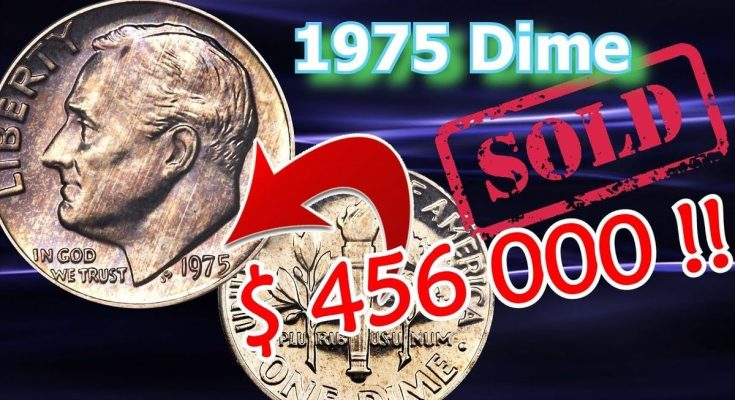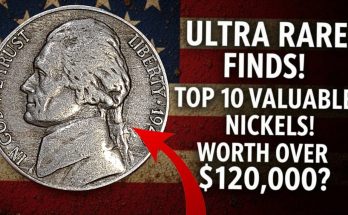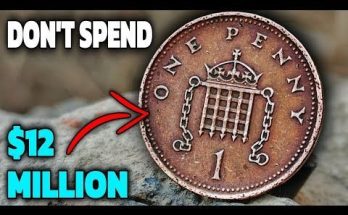🤯 The Half-Million Dollar Mistake: The 1975 ‘No S’ Proof Dime 🤯
The captivating photo and caption—”1975 No S Dime Sells for Almost a Half Million Dollars”—illustrates one of the most astonishing and valuable errors in all of modern U.S. numismatics. This coin is the 1975 ‘No S’ Proof Roosevelt Dime, a tiny 10-cent piece whose exceptional rarity and dramatic story have propelled its value to record-breaking heights, placing it as one of the most sought-after U.S. coins of the last 50 years.
The Story of the Missing Mint Mark
To understand the immense value of this coin, one must first understand how U.S. coins were minted in 1975. Coins intended for general circulation were struck primarily at the Philadelphia Mint (which used no mint mark, or sometimes a ‘P’ on some denominations) and the Denver Mint (‘D’). However, Proof coins—special, mirror-like coins made with polished dies specifically for collectors and sold in protective sets—were struck exclusively at the San Francisco Mint, and they always carried the ‘S’ mint mark located above the date.
The 1975 ‘No S’ Proof Dime is the product of an incredible manufacturing blunder. For reasons unknown—likely a die preparation error that was quickly corrected—two of the dies sent to the San Francisco Mint for striking the 1975 Proof Sets were missing the ‘S’ mint mark. Before the error was detected and the dies destroyed, a minuscule number of Proof Sets were assembled and released to the public containing this flawless, mirror-like Roosevelt Dime without the essential ‘S’ mint mark.
Extreme Rarity = Explosive Value
The key factor driving the value into the hundreds of thousands of dollars is extreme scarcity. In the nearly five decades since 1975, only two authenticated examples of the ‘No S’ Proof Dime have ever surfaced. They were both discovered by the same collector in California, who had purchased multiple 1975 Proof Sets directly from the U.S. Mint. This minuscule population of two coins cements the 1975 ‘No S’ Proof Dime’s reputation as the Number One modern U.S. coin rarity—a status that guarantees massive attention whenever one comes up for auction.
Auction Records That Make History:
The headline is well-supported by auction history:
- 2019 Auction: One of the two known examples, graded PCGS PR68, was sold at a Heritage Auctions event for an astounding $456,000.
- 2024 Auction: The second known example, known as the “Ruth E.” specimen and graded PCGS PR67, went to auction and realized a stunning $506,250, setting a new all-time public auction record for the coin and underscoring the relentless demand for this modern holy grail.
The Crucial Distinction: Proof vs. Circulation
This is the most critical point for any aspiring treasure hunter: you must be able to distinguish the valuable Proof error from the common circulation strike.
- The Common Coin: The Philadelphia Mint struck over 585 million dimes for circulation in 1975, and those also lack a mint mark (as Philadelphia didn’t routinely use the ‘P’ on dimes until 1980). A regular, worn 1975 dime from circulation is worth face value (10 cents). Even an uncirculated 1975 Philadelphia dime is worth only a few dollars.
- The Rarity: The ‘No S’ Proof Dime has a dramatically different appearance. It exhibits the hallmark qualities of a Proof coin:
- Mirror-Like Fields: The flat areas of the coin have a deep, reflective, mirror finish.
- Frosted Devices: The portrait of Roosevelt and the Monticello design elements have a frosted, matte appearance that sharply contrasts with the mirror field.
- Sharp Strike: All details are exceptionally sharp and well-defined, not worn down like a coin found in pocket change.
In essence, you are looking for a perfectly struck, mirror-finish dime from 1975 that has no mint mark above the date. The chances of finding one in circulation are infinitesimally small, but the fact that both examples were found in unopened 1975 Proof Sets means that another set could still be out there, waiting to be discovered. The story of the 1975 ‘No S’ Proof Dime is a thrilling testament to how a single, simple mistake by the U.S. Mint created a treasure that commands a half-million-dollar price tag.
Would you like me to find out about other modern U.S. coin errors that have sold for six-figure amounts?



